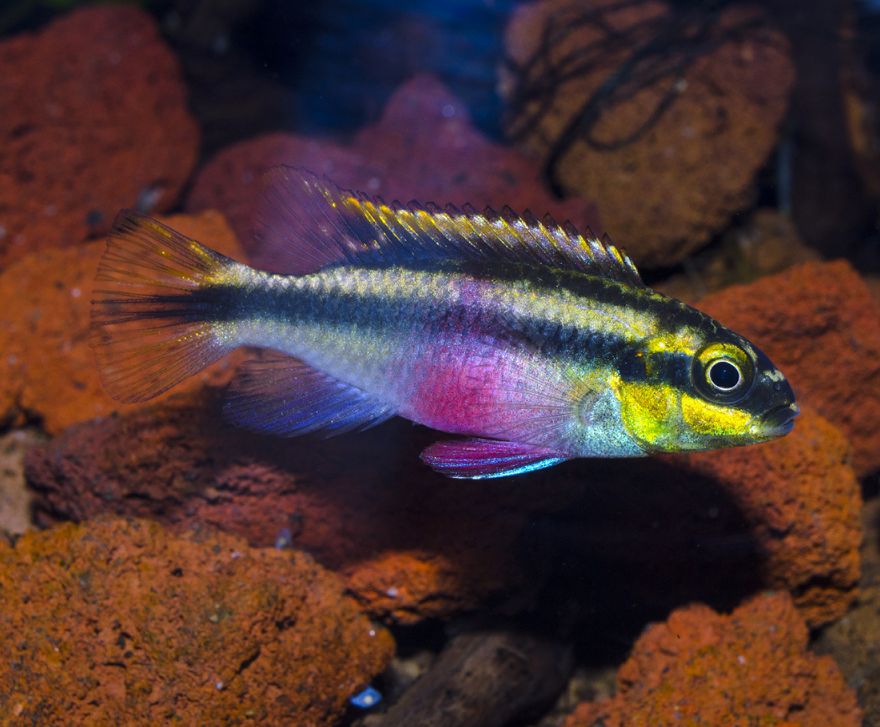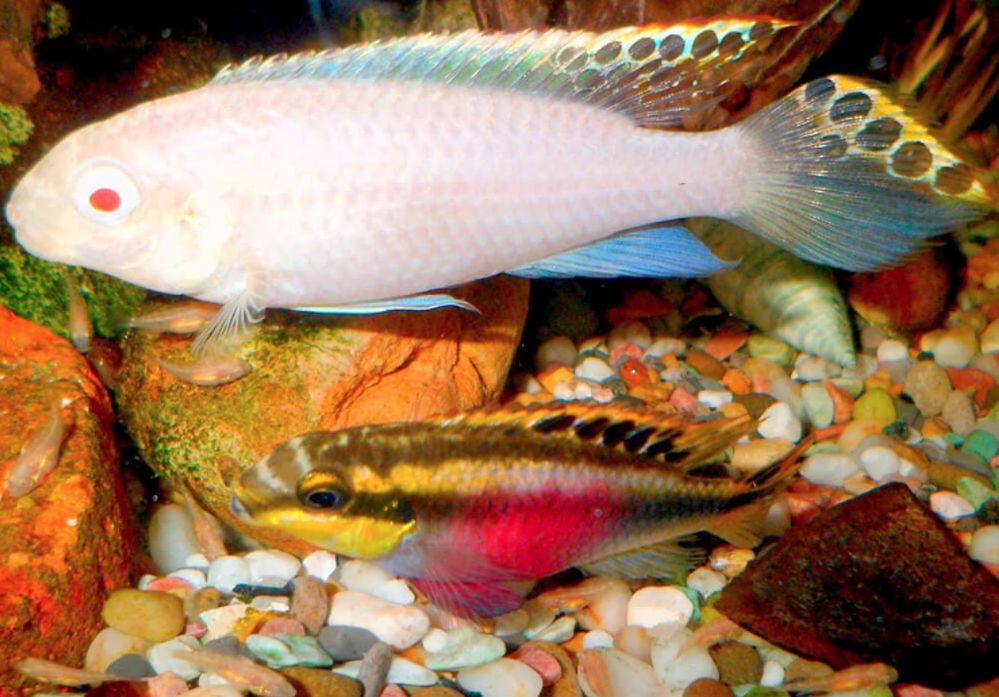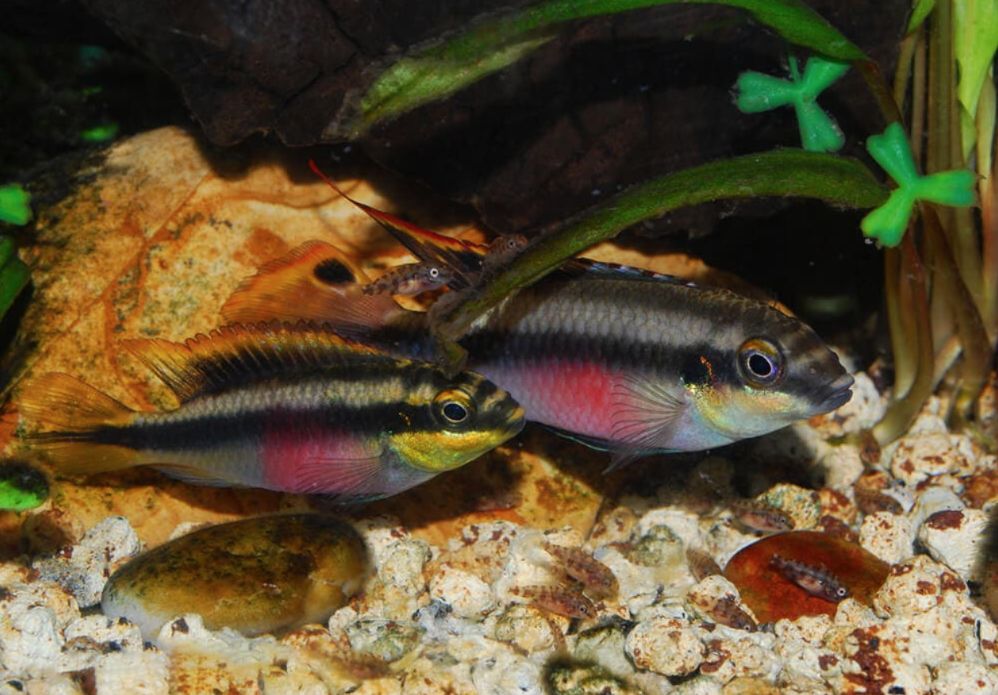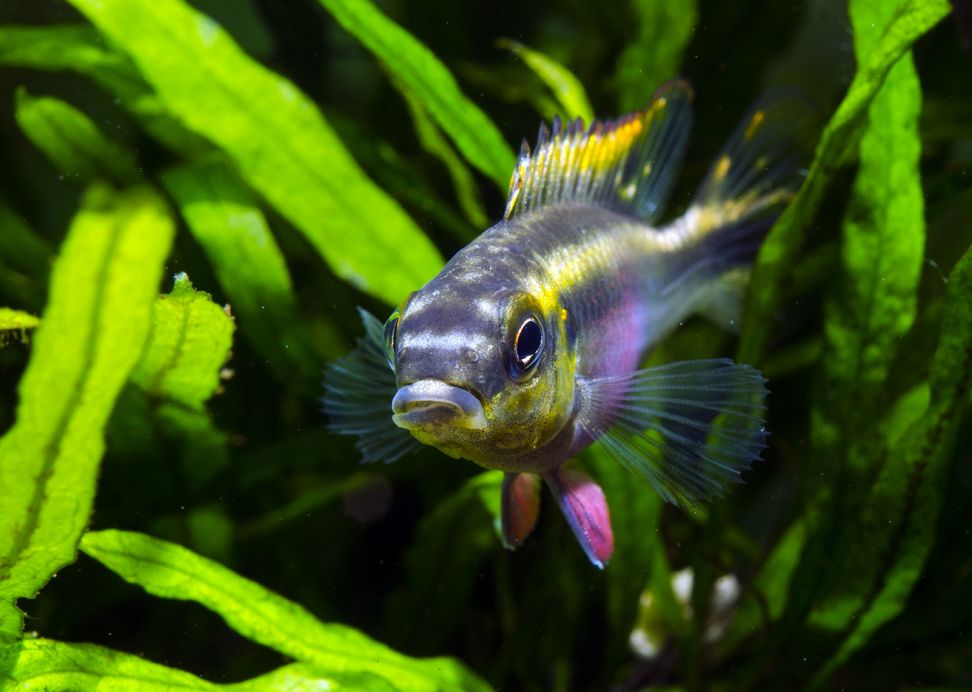Kribensis, a vibrant dwarf cichlid, is a favorite among aquarists due to its striking appearance and relatively low care requirements. The name “Pelvicachromis pulcher” reflects its features: “pelva” means abdomen, “chromis” relates to color, and “pulcher” translates to beautiful, all of which aptly describe this captivating fish. Notably, during spawning, the fish’s abdomen shines and takes on a cherry hue, enhancing its allure. With proper tank conditions, including ample hiding spaces and a balanced diet, kribensis can thrive and bring lively color to your aquarium.

Contents
Habitat in the wild
The kribensis, scientifically known as Pelvicachromis pulcher, is a captivating freshwater fish that belongs to the cichlid family, one of the largest and most diverse fish families globally. Cichlids are favored among aquarium enthusiasts for their vibrant colors, intriguing behaviors, and manageable care requirements, making them an excellent choice for both novice and experienced aquarists.
Native to West Africa, particularly the Niger Delta and coastal areas of Nigeria and Cameroon, kribensis thrive in unique water conditions. While they prefer soft, slightly acidic water with a pH around 6.0 to 7.0 in deeper habitats, they can adapt to the more alkaline and harder waters found in delta regions, where pH can rise to 8.0 or higher. In the wild, these fish inhabit slow-moving rivers, streams, and swamps rich in vegetation, where they find shelter and spawning sites.
Known for their territorial behavior during breeding, kribensis often dig pits or caves where they lay their eggs and nurture their young. The males display vibrant colors, especially during mating rituals, showcasing bright blue and yellow hues that attract potential mates. This species is a mouthbrooder, with the female carrying fertilized eggs in her mouth until they hatch, providing an added layer of protection for the fry. Once the fry are free-swimming, both parents exhibit protective behaviors, ensuring their young are safe from predators.
Description
Size
Kribensis is a relatively small species of cichlid that showcases intriguing size differences between males and females. In the wild, male kribensis typically outgrow their female counterparts, reaching sizes of about 12.5 cm (4.9 inches), while females are generally smaller at around 8.1 cm (3.2 inches). However, in a home aquarium, this dynamic can shift; females often grow larger than males, making them more prominent in tank settings.
On average, adult male kribensis can grow to about 10 centimeters (4 inches) in length, with some reaching the upper end of this range. Females, conversely, are usually smaller, averaging between 7.5 cm and 9 cm (3 to 3.5 inches). This size difference is essential for aquarists to consider, especially during breeding. Larger females may have a higher capacity for carrying eggs and raising fry, while the more prominent males often display vibrant colors that are attractive to potential mates.
Lifespan
In captivity, kribensis typically have a lifespan of about 4 to 8 years. The actual lifespan can vary based on several factors, including the quality of care, diet, water conditions, and genetics.
Color
The kribensis is a visually striking species of cichlid, admired for its vibrant coloration and engaging behavior. The upper side of the body displays a brownish hue with shimmering blue or violet highlights, creating an iridescent effect that catches the light beautifully. The sides and abdomen vary from blue to violet, often showcasing a greenish sheen that adds depth to their appearance. A prominent dark lateral stripe runs along the back, while a similar stripe extends down the body, more pronounced in juvenile fish, which helps them blend into their natural environments among vegetation.
Males typically exhibit 1 to 5 dark round spots bordered in bright yellow on the upper side of their tail, which not only enhances their attractiveness but also plays a role in mating displays. In contrast, females boast wine-red abdominal fins, making them equally beautiful in their own right. This sexual dimorphism not only aids in breeding but also enriches the aesthetic diversity within an aquarium.
The albino kribensis, a color variant of the standard kribensis, is particularly sought after for its unique appearance. Lacking the typical pigmentation, these fish have a predominantly white or pale body complemented by pink or red eyes. Despite these differences in appearance, caring for albino kribensis is remarkably similar to that of their non-albino counterparts. They thrive in similar tank conditions, including water parameters such as pH levels of 6.0 to 7.0, temperatures between 24°C and 28°C (75°F to 82°F), and a well-planted environment that mimics their natural habitat.
| Characteristic | Description |
|---|---|
| Scientific Name | Pelvicachromis pulcher |
| Common Name | Kribensis, Krib, Purple Cichlid |
| Family | Cichlidae |
| Origin | West Africa, Nigeria, Cameroon |
| Habitat | Slow-moving rivers, streams, and swamps with vegetation |
| Size | Up to 4 inches (10 centimeters) |
| Lifespan | 4 to 8 years (in captivity) |
| Behavior | Generally peaceful, can become territorial during breeding |
| Tank Size | Minimum 20 gallons (75 liters) for a pair |
| Water Parameters | Temperature: 75-82°F (24-28°C); pH: 6.0-7.5 |
| Diet | Omnivorous – Flakes, pellets, live/frozen foods, vegetables |
| Compatibility | Peaceful community fish, but can be aggressive during breeding |
| Sexing | Males are larger and more colorful; females have a red belly |
| Breeding | Cave spawners; both parents care for eggs and fry |
| Coloration | Males: Vibrant colors (blue, red, yellow); Females: Duller |

Difficulties in keeping
It’s a plain and small fish, which can be kept in a community tank together with the fishes of equal size. It’s not demanding as for the feed and care, so it can be recommended for the beginners, however, please, keep in mind that the fish is aggressive towards its tank mates during its spawning period.
Care and keeping in a tank
Tank size
A minimum tank size of 20 gallons (75 liters) is recommended for a pair of kribensis. This size provides sufficient space for a breeding pair to establish territories and raise their fry comfortably. However, opting for a larger tank is always advantageous, especially if you plan to keep them in a community setup or want to offer more room for exploration and swimming.
In a larger tank, such as a 30-gallon or 40-gallon setup, you can incorporate additional hiding spots, caves, and plants, all of which contribute to a more secure environment for the fish and help reduce aggression. The presence of varied structures allows kribensis to feel more at home, promoting natural behaviors such as foraging and nesting.
Water parameters
Kribensis have adapted well to aquarium life, having been kept in tanks for many years. Maintaining the proper water parameters is essential for their health and well-being. Here are the recommended conditions for keeping kribensis in an aquarium:
Temperature: Keep the water temperature between 75°F and 82°F (24°C to 28°C). This range closely mimics their natural habitat in West Africa, where water temperatures are typically warm.
pH: Kribensis prefer slightly acidic to neutral water conditions, with an ideal pH level between 6.0 and 7.5. It’s crucial to avoid extreme fluctuations in pH, as stable conditions are vital for their overall health.
Hardness: While kribensis are adaptable to various water hardness levels, they generally prefer relatively soft water. Aim for a general hardness (GH) level between 4 to 12 dGH, which suits their natural preference.
Ammonia, Nitrite, and Nitrate: Regularly test the water for ammonia, nitrite, and nitrate levels. Both ammonia and nitrite should be at 0 ppm, as these substances are toxic to fish. Nitrate levels should be kept as low as possible, ideally below 20 ppm, through consistent water changes.
Chlorine and Chloramine: Ensure your tap water is free from chlorine and chloramine, as these chemicals can be harmful to kribensis. Using a water conditioner will help remove these substances before adding new water to the aquarium.
Water Changes: Regular water changes are vital for maintaining good water quality and diluting accumulated pollutants. Aim for weekly or bi-weekly water changes of about 20-30% of the tank volume to keep the environment healthy.
Decor
Creating a suitable and enriching environment for kribensis (Pelvicachromis pulcher) involves incorporating various tank decorations that mimic their natural habitat while providing essential hiding spots and clear territorial boundaries.
Importance of Hiding Spots
It’s crucial to include a variety of hiding spots, such as flower pots, nut shells, tubes, and caves, especially if you plan to introduce juveniles in the future. These nookeries should be placed in the corners of the tank to establish secure areas. When multiple breeding pairs are present, you’ll soon observe them settling into their chosen homes, which can reduce competition and stress.
Open Swimming Areas
While hiding spots are vital for kribensis, it’s equally important to leave open swimming areas. This allows the fish to display their natural behaviors and explore their environment freely. Kribensis thrive in spaces where they can swim without obstruction, which enhances their overall health and reduces stress.
Cave Spawning Behavior
As cave spawners, kribensis benefit from an environment rich in potential breeding sites. Utilizing materials such as driftwood, coconut shells, ceramic caves, or stacked stones can create enticing caves and crevices that serve as both shelter and spawning sites. These structures not only provide safety for the fish but also encourage breeding behaviors.
Managing Aggression Through Territorial Divisions
To mitigate aggressive behavior among kribensis, it’s advisable to keep breeding pairs, as this helps divide the tank’s territory. By arranging decorations thoughtfully, you can create distinct zones within the aquarium, allowing each pair to establish its space without excessive conflict. This setup encourages the fish to showcase their bright colors to each other along their territorial borders instead of engaging in fights.
Observing Territorial Dynamics
It’s particularly fascinating to observe how each pair divides the tank space into their own home territories. Males often confront other males, while females will do the same, leading to vibrant displays of colors and strength as they demonstrate their dominance at the borders of their respective territories. Watching these interactions not only adds interest to the aquarium but also provides insight into their social behaviors.
Substrate
Proper tank bottom substrate is as important as providing nookeries for kribensis. These fish thrive in environments that closely mimic their natural habitat, and the right substrate plays a crucial role in their behavior and well-being. Kribensis prefer a sandy or small gravel substrate, which allows them to dig and explore. A soft substrate is particularly beneficial, as it enables them to engage in their natural behaviors, such as sifting through the substrate in search of food and creating pits for breeding. This digging activity is not only instinctual but also contributes to their overall happiness and health.
Providing a substrate that allows for digging encourages kribensis to display behaviors typical of their species. By creating pits or burrows, they can establish territories and feel secure in their environment. This behavior is especially important during breeding, as it gives them a suitable space to lay eggs and protect their fry.
Incorporating the right substrate is essential for creating a thriving habitat for kribensis. By choosing sandy or small gravel substrates, aquarists can promote the natural behaviors of these captivating fish, ultimately leading to a more dynamic and healthy aquarium environment. The act of digging not only helps kribensis find food but also allows them to rearrange their environment, which can reduce stress. In the wild, kribensis often create complex burrow systems, providing shelter and safety for their young. The substrate can influence the water quality; finer substrates can help maintain beneficial bacteria, aiding in the nitrogen cycle. Kribensis are known to be quite resourceful, often using materials found in their substrate to construct breeding sites. Observing kribensis sifting through substrate can be a fascinating spectacle, as they display their curious nature and engaging behaviors.
Plants
The fish may dig out some small tank plant, but in general they don’t do any harm to tank plants. Opt for hardy aquatic plants like Java Fern, Anubias, Amazon Sword, or Vallisneria, which are less likely to be uprooted by the fish.
Tank mates
It’s highly recommended to keep kribensis without any other tank mates, since, as we’ve already mentioned above, the fish becomes rather aggressive during its spawning period and while taking care of its juveniles. In case, if you did decide to keep kribensis not alone in a tank, tank mates should be some depth or upper water layer inhabitants and the tank should be spacious enough.
Although kribensis is kept in community tanks, yet you should take seriously the process of choosing its tank mates, since it is still a cichlid, no matter that it is a small one. They become very aggressive while spawning – in my tank they used to force a school of angelfish into the tank corner and made them stay there. At that kribs didn’t do any harm to them, but still their tank mates were continuously stressed.
They may bite the fins of slow tank mates, such as angelfish, though they tend to do this in some crowded tanks because of stress and lack of space. The kribensis needs to have its own territory and hiding spots, in this case it is almost harmless. As for keeping fishes and shrimps together, they’ll definitely feed on small ones, just like Angelfish does.
In general, any fish of equal size will do as a tank mate, especially if they inhabit in different water layers. They also can get on well with other fishes. They don’t harm any tank plants, so you can keep them in a planted tank, but keep in mind that they like digging the tank bottom, especially if it is a sandy one.
Here are some suitable tank mate options for kribensis:
- Other Peaceful Community Fish: Many peaceful community fish can cohabit with Kribensis, provided they have similar water requirements. Some suitable options include:
- Small tetras like Neon Tetras, Ember Tetras, or Black Neon Tetras.
- Rasboras like Harlequin Rasboras.
- Dwarf Gouramis or Honey Gouramis, as long as there is enough space and hiding spots for all the fish.
- Bottom-Dwelling Fish: Since kribensis mainly inhabit the middle and bottom parts of the aquarium, consider adding some bottom-dwelling species:
- Big to medium-sized fishes like Bristlenose Plecos or Clown Loach.
- Corydoras catfish are excellent bottom-dwellers too.
- Peaceful African Cichlids: Some other peaceful African cichlid species from the same region as kribensis might work as tank mates. Just ensure that the species have compatible temperaments and space requirements.
Remember, even within these species categories, individual fish can have different personalities. Always observe the interactions between the kribensis and their tank mates carefully. If any aggression is observed or if a particular fish becomes overly territorial, be prepared to provide separate accommodations if needed.

Diet
Feeding kribensis is straightforward since they are omnivorous and enjoy a variety of food types, including live, frozen, and artificial options. However, it’s best to provide a diverse diet, as this supports their health and enhances their coloration. Since kribensis primarily forage for food on the tank bottom, it’s important to ensure that the food reaches this area without being snatched up by other fish in the mid-water layers.
High-quality pellets or flakes should form the foundation of their diet. Look for cichlid-specific options that are rich in essential nutrients. Additionally, kribensis will relish live and frozen foods such as brine shrimp, bloodworms, daphnia, and mosquito larvae, which are excellent sources of protein and vital nutrients. Spirulina-based foods or algae wafers are beneficial additions that help enhance their colors and overall health.
You can occasionally treat your kribensis to small insects like crickets or fruit flies, and earthworms also make a great natural food source. It’s important to observe your fish’s behavior and adjust the feeding schedule accordingly. Over time, you’ll gain a better understanding of their preferences and needs, ensuring they thrive in your aquarium.
Gender differences: male vs female
It’s quite easy to distinguish between adult male and female kribensis, but identifying the differences among juveniles and young fish can be quite challenging. One indirect indicator is that males are generally larger than females.
Males exhibit more vibrant and colorful patterns, featuring striking shades of blue, red, yellow, and black. Adult males often develop a deep red or orange coloration on their bellies, which becomes more pronounced during breeding or courtship displays. Their dorsal fins are typically elongated and pointed, especially when they are trying to attract a mate, and their anal fins are also longer and more pointed compared to females. In terms of body size, males tend to be slightly larger and more robust.
Females, on the other hand, display more subdued colors, often appearing in beige or brownish hues. While some females may show a faint red or orange belly, it is generally less intense and less prominent than in males. The dorsal and anal fins of females are typically more rounded and shorter, lacking the elongated and pointed features seen in males. Females are usually smaller and more slender than males.
As kribensis mature, these differences in coloration and fin shape become more noticeable, making it easier for aquarists to determine the sex of their fish. This knowledge can be beneficial for breeding purposes and for ensuring a harmonious community in the aquarium.

Breeding
Once you’ve established the proper conditions for breeding, encouraging kribensis to spawn is relatively straightforward. By providing a varied diet of live and plant-based foods, such as brine shrimp, bloodworms, and finely chopped vegetables, the fish quickly become vibrant in color and ready to breed. A well-balanced diet not only boosts their health but also enhances their breeding readiness.
Typically, the female initiates the spawning process by displaying her bright abdomen, which becomes particularly vivid as she prepares to attract the male. To entice him, she curves her body, waves her fins, and shakes, showcasing her readiness. This courtship behavior can be quite captivating to observe. Prior to spawning, it’s common to see the pair clearing gravel and debris from their chosen cave, creating a clean and safe environment for their future fry.
During spawning, the female lays between 40 and 100 eggs, which are often adhesive and stick to the surfaces of their cave. She remains inside the cave to protect them, fanning the eggs with her fins to provide oxygen and prevent fungus. Meanwhile, the male actively guards the cave and the female, swimming around and displaying his vibrant colors to deter any potential threats. The growth rate of the juveniles can vary based on the tank water temperature; at around 29 °C (84.2 °F), they grow rapidly and emerge from the cave in about 4 to 7 days after fertilization.
Although kribensis juveniles can be difficult to spot against the substrate due to their small size and camouflaged appearance, their presence becomes evident when the female leaves the cave to forage for food. Once the juveniles start swimming around, you can feed them with freshly hatched brine shrimp and specially formulated juvenile food, which are rich in the nutrients necessary for their growth. As the juveniles become more active, their parents take on a nurturing role, often milling live food in their mouths before distributing it to the young, showcasing their attentive parenting.
In some cases, only one parent will take full responsibility for the juveniles, leading to aggressive interactions between the parents, particularly if the other parent feels threatened. If this occurs, it’s advisable to remove one parent from the tank to prevent conflict, ensuring the safety of the fry. Within 2 to 4 weeks, the juveniles will reach about 1.25 cm (0.5 in) in length, at which point they should be separated from their parents to ensure optimal growth and health.
By this time, the breeding couple will likely be ready to spawn again, especially if placed back into a tank with suitable breeding conditions. This cycle of breeding and caring for their young showcases the fascinating behaviors of kribensis and makes them a rewarding species for aquarists interested in breeding, providing endless opportunities for observation and enjoyment.